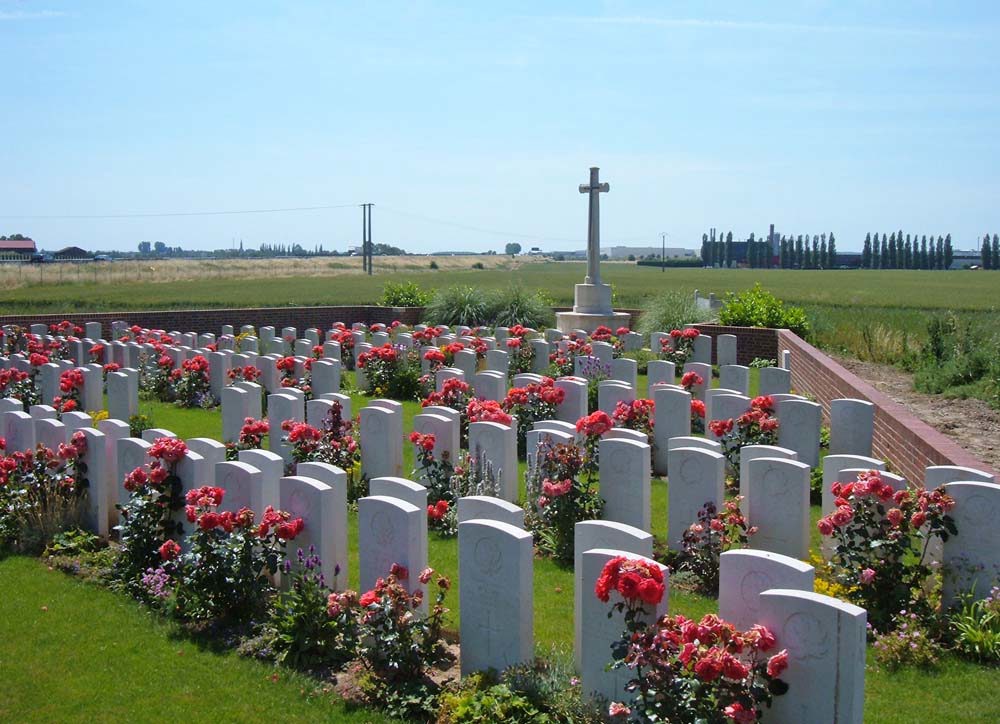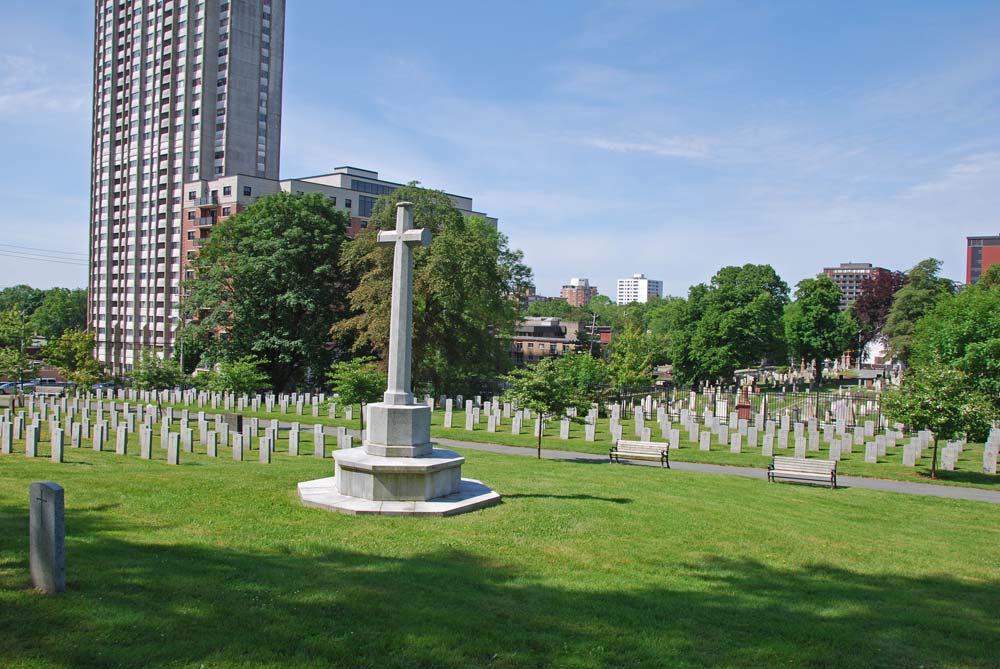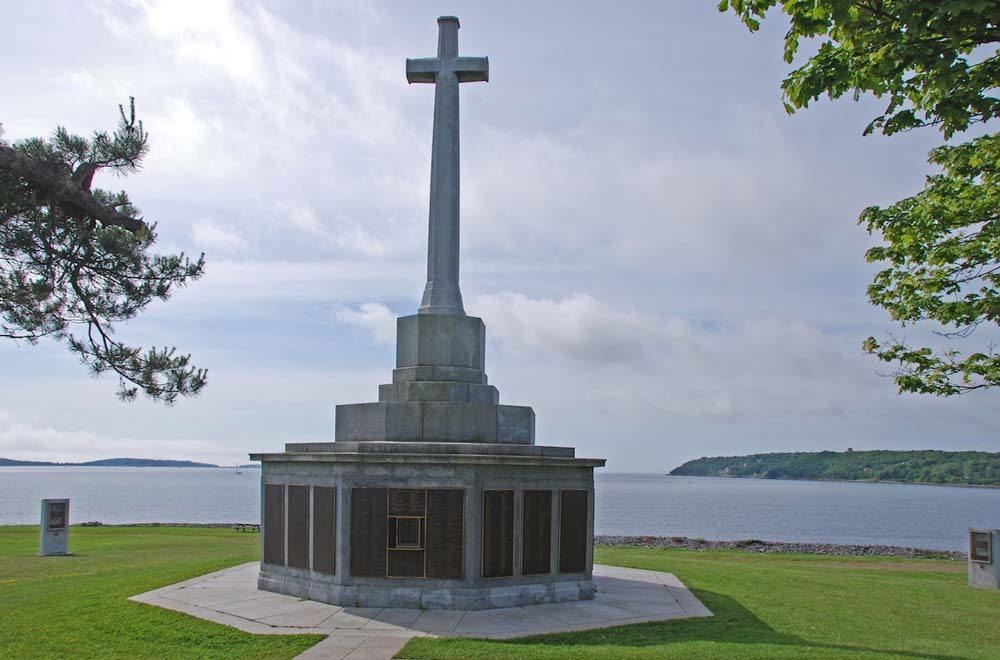11 July 2022
WW1 Canadian memorials to visit
Get to know more about our WW1 Canadian memorials and the nation-defining role Canada played in the conflict with this guide to our war graves.

Currently, we look after 1,807 different locations in Canada related to World War One. These range from individual burials found in singular graveyards, to purpose-built Commission cemeteries, to grand memorials commemorating thousands of names.
You will also find several, iconic locations where Canadian war graves and WW1 memorials sit in France and Belgium. More on these war memorials and cemeteries later.
Where are Canada's WW1 memorials?
 Image: © IWM Q 4707
Image: © IWM Q 4707
You will find Canadian war memorials all over the country. From Newfoundland to Vancouver, and in between, our sites stretch the length and breadth of the nation.
Canadians who served and fell overseas are commemorated in some of our most iconic French and Belgian sites too, such as the monumental Vimy Memorial, erected at the location of the Battle of Vimy Ridge.
Who is commemorated on Canadian war memorials?
The Canadian war memorials in this article represent those who gave their lives during World War One. The conflict was the bloodiest ever fought by Canadian soldiers, airmen, and naval personnel, tragically resulting in tens of thousands of war dead.
Roughly 66,000 Canadian and Newfoundland (Then a separate entity) men and women fell across the war, whether fighting on the front lines, during training, transit, or just general involvement with the war effort. A further 173,000 would be wounded.
It’s our ongoing mission to ensure their war graves and memorials are maintained and their stories told.
The impact of the First World War on Canada
The Great War had an enormous impact on Canada’s history and identity. For many, it’s considered a foundational conflict; the time when Canada was beginning to emerge as its own nation. The first footsteps towards Canadian independence were made during the First World War.
What was Canada's most significant contribution to WW1?
 The Canadian contribution to the Great War is extremely significant. By the end of the war, the Canadian Expeditionary Force (CEF) would number 630,000 of which 530,000 were volunteers. Around 4,000 or so would come from the First Nations’ indigenous population.
The Canadian contribution to the Great War is extremely significant. By the end of the war, the Canadian Expeditionary Force (CEF) would number 630,000 of which 530,000 were volunteers. Around 4,000 or so would come from the First Nations’ indigenous population.
Over 400,000 Canadians would be deployed to Europe where Canadian infantry would fight in some of the most storied battles of the war. The nation’s main fighting force was the Canadian Corp, comprised of 100,000 men by the end of 1916.
But Canada’s legacy is not limited to the earth. By 1918, 25% of Royal Air Force pilots were Canadian. In fact, William Bishop of Owen Sound, Ontario, became the Allies’ most successful fighter ace, notching up 72 aerial victories by the war’s end.
In terms of naval power, Canada’s navy was focussed diligently patrolling territorial waters. Many thousands would join the ranks of the Royal Navy, fighting alongside their comrades from all over the world.
How did WW1 change Canada's identity?
As a subject of the British Empire, the Canadian Government was obligated to go to war in 1914, despite its Dominion status. By 1918, the nation’s experiences had helped instil a new self-confidence in the nation.
At the beginning of World War One, many Canadians, particularly English speakers, would have felt British or held some sort of hybrid British-Canadian identity.
 Image: General Sir Arthur Curry
Image: General Sir Arthur Curry
A combination of pride in their battlefield accomplishments, particularly Vimy Ridge, and the sacrifice of so many young men on European battlefields, led to Canada being convinced of the importance of steering its own destiny and character.
Canada had answered the call, paid in blood, and now sought respect and a higher degree of autonomy. Canadian Prime Minister Sir Robert Borden was instrumental in ensuring Canada and other Imperial Dominions were given a voice in the post-war peace negotiations that culminated in the Treaty of Versailles. Canada was beginning to find its own voice.
The signs of independence were being made on the battlefield. June 1917 saw the appointment of a Canadian, Lieutenant-General Sir Arthur Currie, as head of the Canadian Corps. Currie subsequently gained a reputation as one of Allies’ most formidable generals.
Full independence was a long march for Canada. In 1931, the Statute of Westminster was introduced, giving Canada and other dominions full legal freedom and equal status with Britain. It would take a further five decades for Canada to become fully independent – a journey helped along the way by the nation’s contribution to the Great War.
Canadian WW1 memorials in France
Vimy Memorial
Heading north from Arras, passed the gently rolling wheat fields, leafy woodland, and picturesque northern French countryside, you’ll eventually find a high point, rising 30 metres high, dominated by a white, shining stone monument. Its thrusting twin towers stand vigilant amidst the pastoral greens and yellows, lending it a commanding character. This is the Canadian National Vimy Memorial.
Vimy Ridge memorial facts
- Opened on 26th July 1936 by King Edward VIII
- Designed by architect W.S Allward
- Sits atop Hill 145 – an important location during the Battle for Vimy Ridge
What is the Vimy Ridge memorial made of?
The construction of the Vimy Ridge memorial was unique and pioneering at the time. The architect, W.S Allward, decreed the best way to build his ambitious memorial would be to bond limestone blocks to a cast concrete frame.
11,000 tonnes of steel-reinforced concrete act as the Vimy Memorial’s base. Its soaring twin pillars contain a combined 6,000 tonnes of Seget limestone. The limestone is what gives Vimy its almost luminous white finish.
What is unique about the Vimy Ridge memorial?
The Canadian National Vimy Memorial is the largest overseas monument to Canada’s Great War casualties.
Interestingly, the site went almost undamaged during World War Two, when the Allies were once again forced to dislodge entrenched Germans soldiers from positions along Vimy Ridge.
What’s more, the whole site is a unique mix of preserved trenches and the extensive tunnel system utilised by the Allies in the Battle for Vimy Ridge. These can still be visited, acting as a humble reminder of the terrible conditions and trench warfare Great War soldiers on both sides had to endure.
Vimy Ridge memorial names
Despite the architect’s initial objections, the Vimy Ridge memorial proudly displays the names of over 11,000 Canadian soldiers who died in France during World War One but have no known grave.
Many of the names inscribed on the Vimy Memorial’s limestone blocks are those who died during the Battle for Vimy Ridge.
Vimy Ridge monument symbolism
In addition to the names of the missing, the Vimy Ridge Memorial holds a strong symbolic meaning. It doubly acts as a monument to all Canadian soldiers that have fallen in overseas conflicts, particularly the 66,000 who gave their lives for their country in battle, as well as a general monument to all Canadians who served in the armed forces.
Battle of Vimy Ridge
For some, The Battle of Vimy Ridge was a nation-building event for Canada.
 Fought between the 9-12th of April 1917, it marked the first time all four divisions of the Canadian Corps fought as a single formation. Due to the size and scope of the force arrayed to dislodge the three German divisions holding Vimy Ridge and the strategic Hill 145, the Canadians were backed up with artillery and support from the 24th British Division.
Fought between the 9-12th of April 1917, it marked the first time all four divisions of the Canadian Corps fought as a single formation. Due to the size and scope of the force arrayed to dislodge the three German divisions holding Vimy Ridge and the strategic Hill 145, the Canadians were backed up with artillery and support from the 24th British Division.
It took nearly three full days of hard fighting, but eventually, the Canadians were able to force their Imperial German opponents off the ridge and take the high ground.
Casualties were high. The Canadian Corps suffered over 10,600 casualties – around 10% of their total fighting force – with roughly 3,500 killed. The German Sixth Army losses are not recorded, but at least 7,000 were captured as prisoners of war.
How was Vimy Ridge a turning point in WW1?
The level to which Vimy Ridge was a turning point is debated, but some argue the battle made a notable shift in momentum that would eventually lead to the conclusion of World War One in November 1918.
After Vimy and the capture of Hill 145, the Canadian Corps had taken more ground, more prisoners, and more guns than any British advance in the previous two and a half years of fighting.
For the Canadian troops, it also represented more independence in command. They continue to play a vital role in the final allied victory, particularly in spearheading the 100 Days Offensive.
Vimy Ridge restoration
While its prominent position atop the 60m tall ridge makes it stand out, the Vimy Memorial’s location does leave it exposed to the elements. Over the years, wear and tear from rainfall and weather led to the limestone losing its lustre and the names of the fallen becoming obscured.
An extensive restoration project was undertaken between 2005-2007 to restore the Vimy Memorial to its original glory. Repairs to the platform, terrace, stairs, and masonry were undertaken. Lime deposits left by water moving in and out of the structure were removed. All the memorial’s names are visible once more.
Interestingly, the restoration team was able to track down material and repair any damage using materials sourced from the original quarry in Croatia.
Canada Cemetery, Tilloy-Lez-Cambrai

The Canada Cemetery, Tilloy-Lez-Cambrai contains 265 burials, including 25 unidentified casualties.
Tragically, many the casualties buried here come from fighting around Cambrai in October 1918 – just over a month before the November 11th armistice when the guns fell silent on the Western Front.
One of these was Corporal George Herbert Ledingham. Ledingham had previously been an unidentified casualty, so his name was added to the Vimy Memorial amongst his comrades with no known grave.
Working alongside the Canadian Department of National Defence Directorate of History and Heritage, we were able to identify Ledingham and a rededication ceremony was undertaken in November 2021 to give the solider a proper headstone.
Tilloy was taken by the Canadian Corps in October 2018 during the battle for Cambrai. Cambrai was a major transport node during World War One and its capture ensured control of the sector after years of conflict.
Canadian WW1 memorials in Belgium
The fighting men of Canada faced their baptism of fire in Belgium in 1915. Canadian forces were present in the First Battle of Ypres. They would lose over 6,000 troops in Canada’s first major engagement of the war.
The Canadian Expeditionary Force would be present at more important Belgian campaigns throughout the rest of the war. Canadian troops under Sir Arthur Currie were bought in to reinforce British efforts during the Third Battle of Ypres, also known as Passchendaele, for example, with the influx of fresh troops helping finally break the German lines in November 1917 after a month of hard fighting.
Ypres (Menin Gate) Memorial

Ypres (Menin Gate) is one of our most iconic Belgian memorials. Straddling a major thoroughfare through which hundreds of thousands of Allied troops passed across the course of World War One.
The gate commemorates those who fell fighting in and around the Ypres Salient. Canadian names mingle with those of Indian, Australian, South African, and British troops. Canadian soldiers represent round 7,000 names of the near 55,000 on the Menin Gate’s panels.
Canadian First World War memorials in Canada
Naturally, there are multiple sites commemorating Canada’s war dead on home soil.
Halifax Fort Massey Memorial

Not all the casualties we look after came from battlefield actions. Deaths in accidents or training are counted too, and we’re proud to care for these individuals too.
In the case of the Halifax Fort Massey Memorial, the Memorial commemorates two men who died during the Halifax Explosion and whose bodies were never recovered.
The Halifax Explosion was one of the most tragic incidents of World War One. On the morning of 6th December 1917, a Belgian trawler collided with a French ship holding tonnes of ammunition in Halifax Harbour. The resulting explosion wiped out half a mile of the city. 1,500 people were killed.
Halifax Memorial

The Halifax Memorial overlooks the cool, grey waters of the Atlantic Ocean. Its maritime location is fitting as it commemorates more than 3,000 Canadian sailors, merchant seamen, soldiers and nursing sisters who died at sea with no known grave.
Around 270 of the Halifax Memorial’s names are Great War casualties.
Victoria Memorial
 Within the grounds of the Ross Bay Cemetery, Victoria, Vancouver, sits a solid granite obelisk; a simple memorial bearing almost 40 names of Canadian sailors lost at sea.
Within the grounds of the Ross Bay Cemetery, Victoria, Vancouver, sits a solid granite obelisk; a simple memorial bearing almost 40 names of Canadian sailors lost at sea.
The names on the Victoria Memorial are those sailors who died during the sinking of HMCS Galiano. The fisheries patrol vessel was lost in stormy seas after leaving port on 30th October 1918. The war would be over within two weeks.
HMCS Galiano bears the tragic but unique distinction of being the only Canadian war vessel lost at sea during World War One.
The Quebec Memorial, Pointe-Claire Field of Honour
The Commonwealth War Graves Commission built the Quebec Memorial in the Montreal Pointe-Claire National Field of Honour to commemorate the Commonwealth war burials in the Province of Quebec whose graves can no longer be marked or maintained.
The National Field of Honour was established in 1930 and is operated by the Quebec Branch of the Last Post Fund as a permanent memorial of gratitude to Canadian and Allied veterans who served their country in time of war.
How to find Canadian war memorials
Tracking down our Canadian war memorials is simple. Just head on over to our Find War Memorials and War Cemeteries search tool to begin your search.
Select “Canada” from the country options and all of our Canadian sites will be revealed. You can then refine your search based on casualty numbers, locality, and conflict.
Alternatively, search “Canada” in our global search tool to bring up more results. You can also find more information about Canadian war records here.








